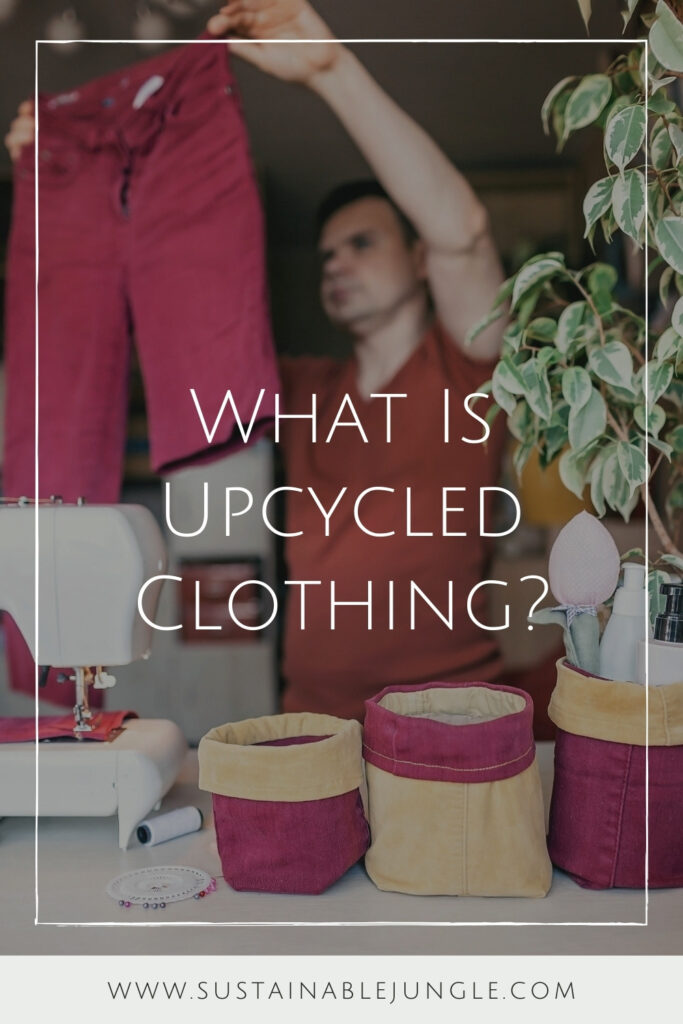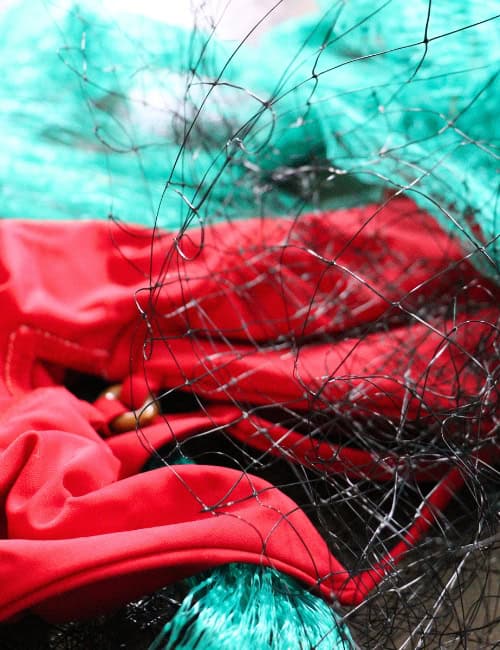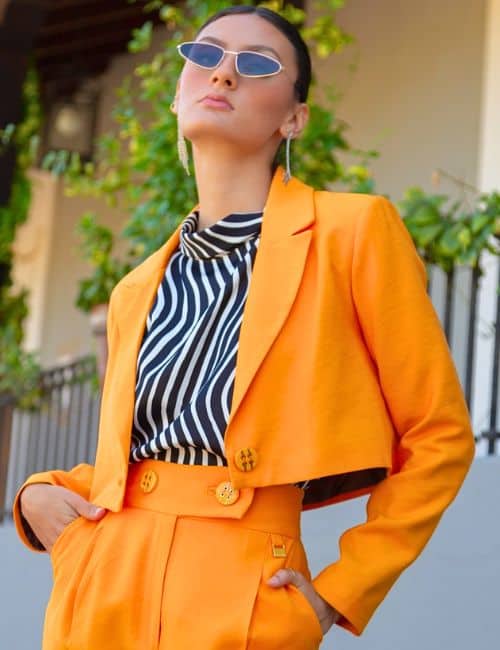
What Is Upcycled Clothing & Why It’s A Timeless Fashion Trend?
Sure, your wardrobe may need a makeover, but you know what’s in need of a complete overhaul?
The global fashion industry.
Current linear-fashion processes—the straight (and short) line from design to disposal—wreak havoc on the environment.
As in 92 million tons of textile waste and 2.1 billion tons of carbon emissions annually.
The good news?
There’s an uprising of zero waste fashion brands and designers who are embracing the concept of circularity in an attempt to avoid fast fashion and its destructive impact.
And in those circles, we’re hearing a lot about “upcycled”.
But what is upcycled clothing and what are the benefits of upcycling clothes for our wardrobes and for the planet?
We’ll answer these questions and more as we dive into this latest sustainable fashion trend and find out how we can start (up)cycling our way to a greener future.
1. WHAT DOES UPCYCLED CLOTHING MEAN?

First things first: what is upcycled fashion, exactly?
Upcycled clothes are made from unwanted materials that would otherwise go to landfills.
This could be unwanted clothing, unwanted textiles, clothing scraps from textile factories, or surplus garments or fabrics (also known as deadstock).
Many types of fabrics can be repurposed into clothing and there’s often a “mix-and-match” approach with new items being refashioned from a combination of materials.
The only limit to this creative repurposing is your imagination.
Think: the plastic film from old cassette tapes and used USB cables are examples of unconventional material choices used for upcycling in fashion.
2. UPCYCLED CLOTHING VS RECYCLED CLOTHING
Upcycling vs Recycling
These terms are often used interchangeably and therefore incorrectly. But it’s important to understand upcycling vs recycling as there is a material (pun intended) difference worth noting.
Recycling is an industrial process that takes a material, breaks it down, then creates a new material from which new products can be made.
This can be done mechanically (i.e. cotton being shredded down and its fibers rewoven into a recycled cotton fabric) or chemically (i.e. PET plastic bottles or fishing nets being melted down and respun into polyester or nylon fibers, respectively).
Generally speaking, the new product bears no resemblance to the recycled materials comprising it.
Sustainable swimwear made from ECONYL® looks nothing like the abandoned fishing nets from which the fabric is made.
Upcycling is something quite different. It takes an unwanted item and improves it (in a more recognizable way) so it can be used again.
Upcycled furniture might involve sanding, repainting, and replacing handles to create a fresh new piece.
It’s the same with clothing.
Upcycled clothing takes an existing garment and improves it, whether by combining it with other garments and materials or adding ornamental flare, like using embroidery and patchwork to mend holes.
While repairing flaws is one of the benefits of upcycling clothes, upcycling goes beyond repairing an item. You can (and often do) end up with something quite different from the original piece.
Items can also be repurposed for a different function. For example, vintage curtain fabrics can be turned into clothing or vice versa.
The key is that upcycling takes waste material and transforms it into something better and more valuable—the “up” (as in upgrade) part of “upcycling”.
Upcycling vs Downcycling
But what about upcycling’s polar-opposite, “downcycling”?
Essentially, it’s when an item is repurposed into something less valuable.
Cutting up an old t shirt into rags for cleaning or repurposing cloth nappies as quasi-mop heads are examples of downcycling.
In terms of textile recycling, it’s also called downcycling when a material can’t be recycled back into the same type of material in order to make new textile products of the same value.
For example, some mixed fiber fabrics can only be “downcycled” into industrial materials like carpeting or insulation.
So, on the sustainable fashion spectrum, upcycling is usually preferred over downcycling (if possible).
3. WHAT ARE THE BENEFITS OF UPCYCLED CLOTHES?
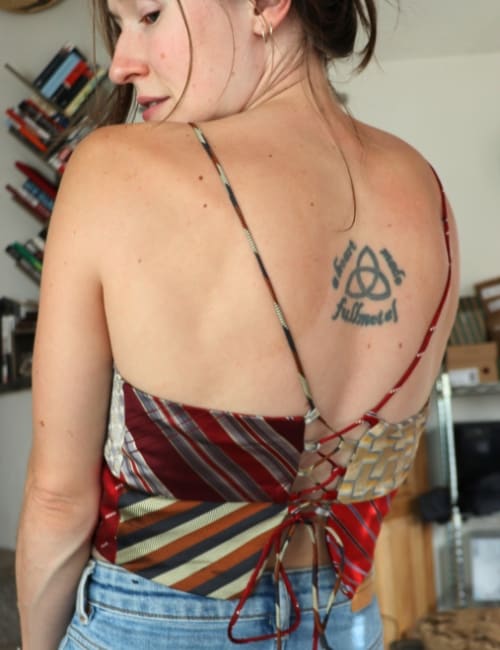
What does upcycled clothing mean for the environment?
Well, aside from getting a fresh and often funky new look, it tackles major issues in the fashion industry by reducing environmental and social impact.
- Less reliance on virgin materials:
Between deforestation, greenhouse gas emissions, microplastic pollution, soil degradation, water consumption, and water pollution, the cultivation and production of raw materials have a serious impact on the planet.
While the use of sustainable fabrics can partially alleviate these issues, anything that reduces the raw materials needed for clothing is a good look, sustainably speaking.
- Dealing with textile waste:
The fashion industry is responsible for vast amounts of textile waste.
Globally, only 1% of clothing waste is recycled, meaning the majority of unwanted clothing and footwear end up in landfills or incinerators.
Post-consumer waste isn’t the only culprit.
It’s estimated that 25-40% (!) of the fabric used in garment production is wasted, even though at least 50% of that could be upcycled into new clothing.
Dealing with textile waste requires a multilayered circular-minded approach that takes into account the whole lifecycle of a piece of clothing—and it starts at the design stage.
The longer we keep clothing in circulation, the better.
Upcycling is one way to do this, along with shopping at thrift stores, opting for online clothing rental for lesser worn pieces, repairing garments, and embracing a minimalist wardrobe.
- A solution for mixed fabrics:
While there are an increasing number of options to recycle old clothes (some of which even allow you to recycle clothes for money in the form of store credit), not all clothes can be recycled.
Some mixed fabrics, e.g. synthetic/natural blends can’t be recycled so upcycling these fabrics into new clothing is a way to give them a second life.
What does upcycled fashion mean for people?
- Less harmful social practices:
Sweatshop labor is often applied to manufacturing across all industries, but people closely associate the term with the fashion industry in particular.
And for good reason.
The Rana Plaza garment factory collapse exposed the sort of dangerous conditions many garment workers face—typically for below-living wages.
While an increasing number of sustainable clothing brands are running down the runway toward fair trade labor practices, it’s not a perfect end-all-social-woes solution.
Upcycling is one of the best ways to avoid the human rights abuses common in fast fashion and the damaging impact it has including on workers in the supply chain.
2. Supporting small businesses:
Many of the businesses making and selling upcycled clothing are run by solopreneurs or small teams so you can pat yourself on the back for supporting small, ethical companies.
What Does Upcycled Fashion Mean For Your Wardrobe?
- One-of-a-kind bespoke fashion:
Each upcycled fashion item is unique.
While utilitarian in nature, upcycling is also a creative process.
It appeals to those who like a design challenge since it involves working within the parameters of the waste materials available to come up with a sustainable (and importantly stylish) solution.
The possibilities are endless!
- Wearable keepsakes:
Upcycling can turn treasured textiles into something you can wear or use in some other way.
You might have a piece of clothing of sentimental value that’s no longer wearable: a sweater knitted by a grandparent, a garment gifted from a beloved friend, or a keepsake shirt from summer camp.
Upcycling means you can creatively repurpose these into a wearable piece of clothing, accessories, or home goods (old t shirt quilts, anyone?), giving loved items a second life.
- An affordable wardrobe refresh:
If you’re DIY-ing your own upcycled clothes, it’s a low-cost way to achieve an instant wardrobe refresh.
The bottom line: upcycled clothes are good for the planet, people, your wardrobe, and your sustainable wallet.
4. HOW TO UPCYCLE CLOTHES
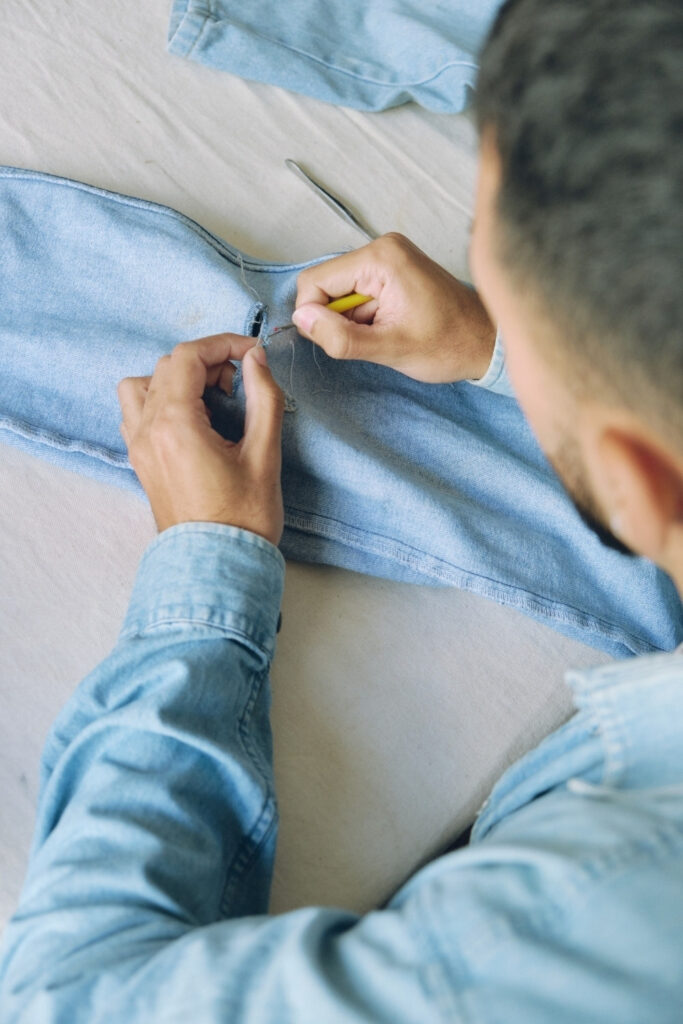
Now that you’re down (er…up?) with the benefits of upcycled fashion, read our deep dive on tips for upcycling old clothes DIY style.
For the CliffNotes, read on.
There are a few different options depending on how involved you want to get with the process.
DIY Upcycled Clothing
Wondering what to do with old clothes?
Keep garb out of the garbage and see if you can figure out if there’s a way to transform them into a fresh new piece for your wardrobe.
If you’re handy with a sewing machine (or hand sewing in some instances) the only limit is your imagination.
With a few well-positioned cuts and ties, you can refashion a t shirt into a breezy summer piece.
If you have an upcycling project in mind but don’t have any suitable clothes then you can snag some from your local thrift store.
Especially try to source from sales sections and discount racks, as these garments are probably living rent-free (i.e. close to the end of the line).
Online Repair Services
If you’re lacking in the sewing skills department or simply don’t have the time to refashion your own clothes, there are other options.
You may have a local tailor who can help with your upcycling needs. There are also a number of online clothes repair services that offer vintage revival services.
We’re talking beyond “make do and mend”, more like “make better and upcycle”.
Upcycling Clothes Businesses and Brands
Some brands such as Fanfare Label offer an upcycling service.
Send them an old pair of your jeans and they’ll turn them into a bespoke customized piece. You can specify embroidered or painted patterns and text.
Footwear brand Vibram has repair shops in several countries around the world where you can customize your favorite shoes with a pair of Vibram soles.
If you’d rather support small, Etsy is an excellent place to seek out specialized upcycling artists, many of which offer custom upcycling options.
5. UPCYCLING BRANDS AND FASHION DESIGNERS
Upcycling is on the rise with an increasing number of brands and fashion designers getting on board with the creative repurposing of various materials.
Who’s doing the upcycling, you ask?
Upcycling Brands
You can support the upcycling fashion movement by buying from one of the many upcycled clothing brands, like:
- Fanfare: This London-based clothing brand is the place to go for upcycled bohemian clothing and sustainable streetwear.
- Patagonia: Patagonia Recrafted Collection repurposes customers’ old Patagonia garments that have been reclaimed through their Worn Wear program.
- R-Coat: R-Coat collects broken (hopefully) eco friendly umbrellas from community collection points across Italy and Portugal and transforms the non-recyclable fabric into stylish coats and hats.
- RE/DONE: This vintage clothing brand partners with Levi’s Jeans to create upcycled denim clothing.
- Etsy: Not a brand, but again, this maker marketplace offers near-infinite potential to find upcycled clothing boutiques creating one-of-a-kind sustainable pieces.
Upcycling Fashion Designers
Sustainability-focused fashion designers are showcasing innovative answers to “what is upcycled fashion?”.
They’re championing the use of sustainable materials, raising awareness about environmental issues, and challenging us to think outside the box when it comes to sustainable solutions.
In doing so, they’re inspiring others to follow suit and bringing sustainable fashion to an international audience.
If you’re looking for some inspiration on how to upcycle clothes here are a few designers bringing upcycled clothing to the catwalk:
- French designer Marine Serre (@marineserre_official) upcycles a variety of fabrics for her collections including her signature crescent moon print pieces.
- Kevin Germanier (@kevingermanier) does upcycled glamor for the likes of Bjork and Lady Gaga using colorful beads and other waste materials.
- London-based designer Matthew Needham (@matthewneedhamstudio) uses unconventional materials like fly-tipped waste and deadstock material from luxury houses.
- French-Israeli fashion and textile designer Benjamin Benmoyal (@benjaminbenmoyal) takes the plastic film from old music cassettes and VHS tapes to create a unique woven fabric.
- UK-based designer Tega Akinola (@tegaakinola) uses broken ethernet cables and old Nike socks for her innovative footwear designs.
You can also watch the yearly Redress Design Award, the world’s biggest sustainable fashion competition providing a stage (er, runway) to up-and-coming designers incorporating upcycled materials into their work.
FINAL THOUGHTS ON WHAT IS UPCYCLED CLOTHING?
What does upcycled clothing mean for our planet?
It means less waste, less pollution, less carbon emissions, and less energy consumption.
It keeps clothing and textiles in circulation for longer and it’s a creative and effective way to promote slow fashion.
Upcycling in fashion lets you indulge in your love of clothes by permitting a regular wardrobe refresh.
After all, the most sustainable clothes are the ones already in your wardrobe. They might just need a bit of jazzing up from time to time.
In the spirit of circularly, help us (up)cycle this article by sending it to any sustainable fashionistas you know.
